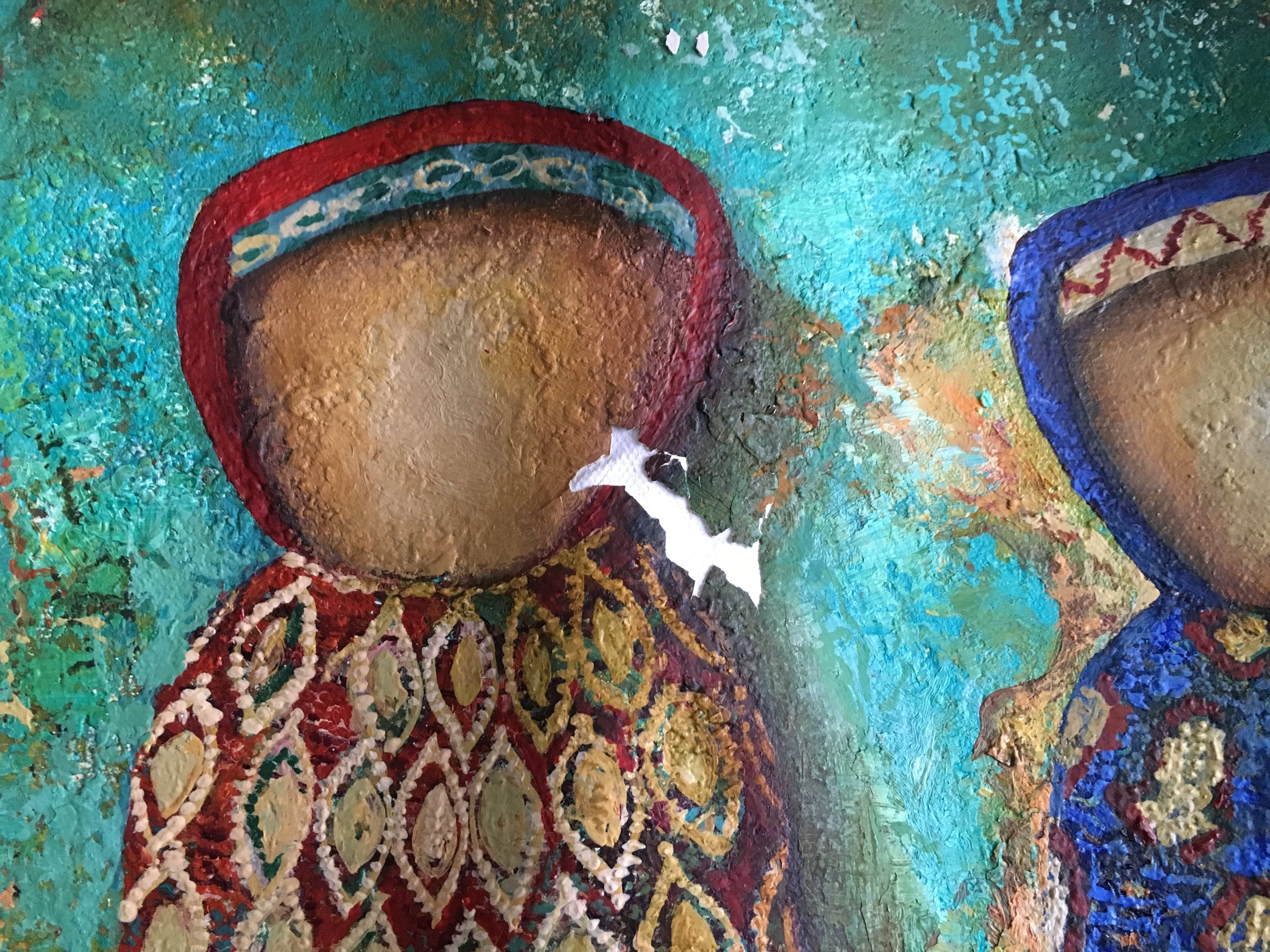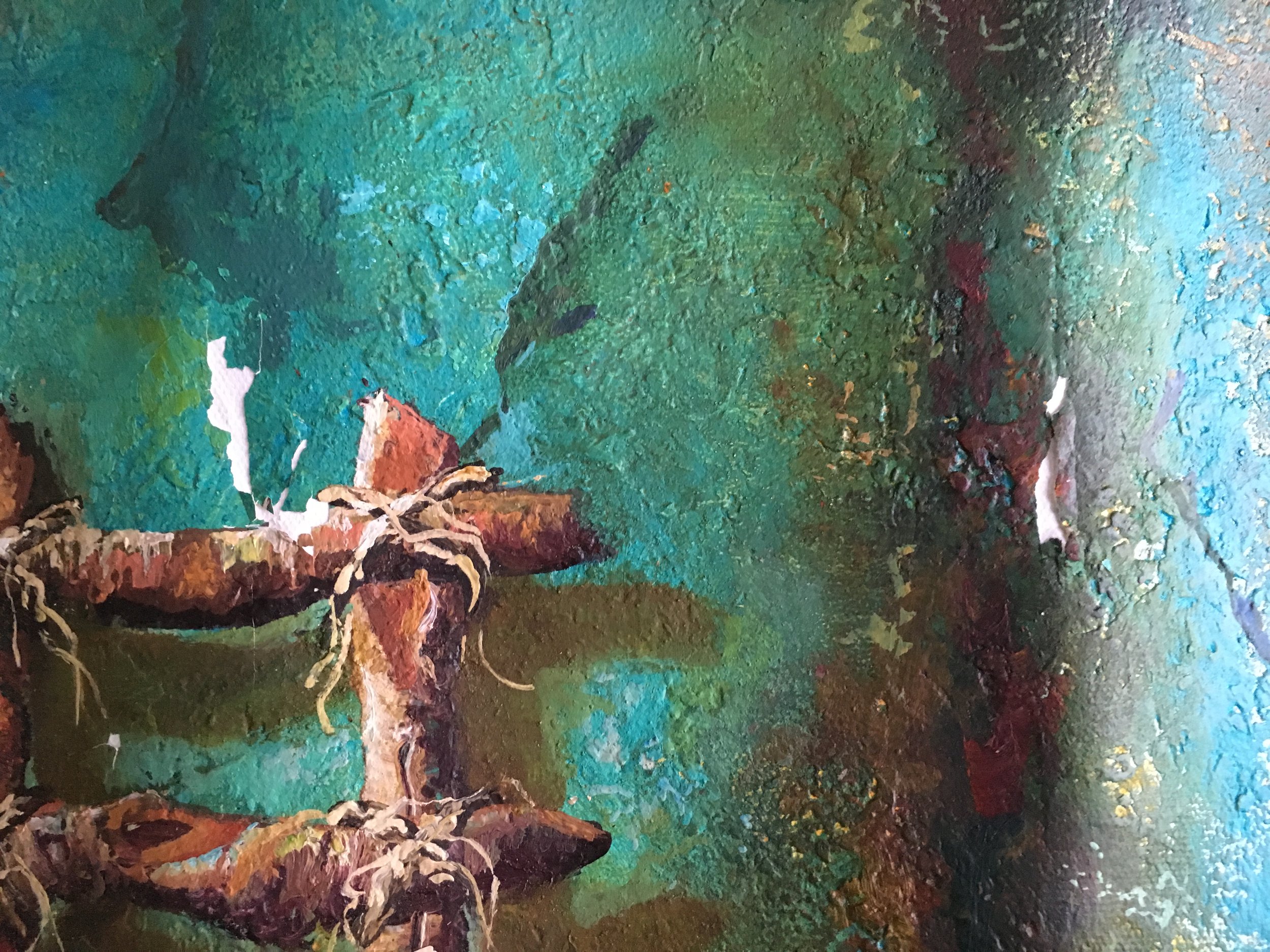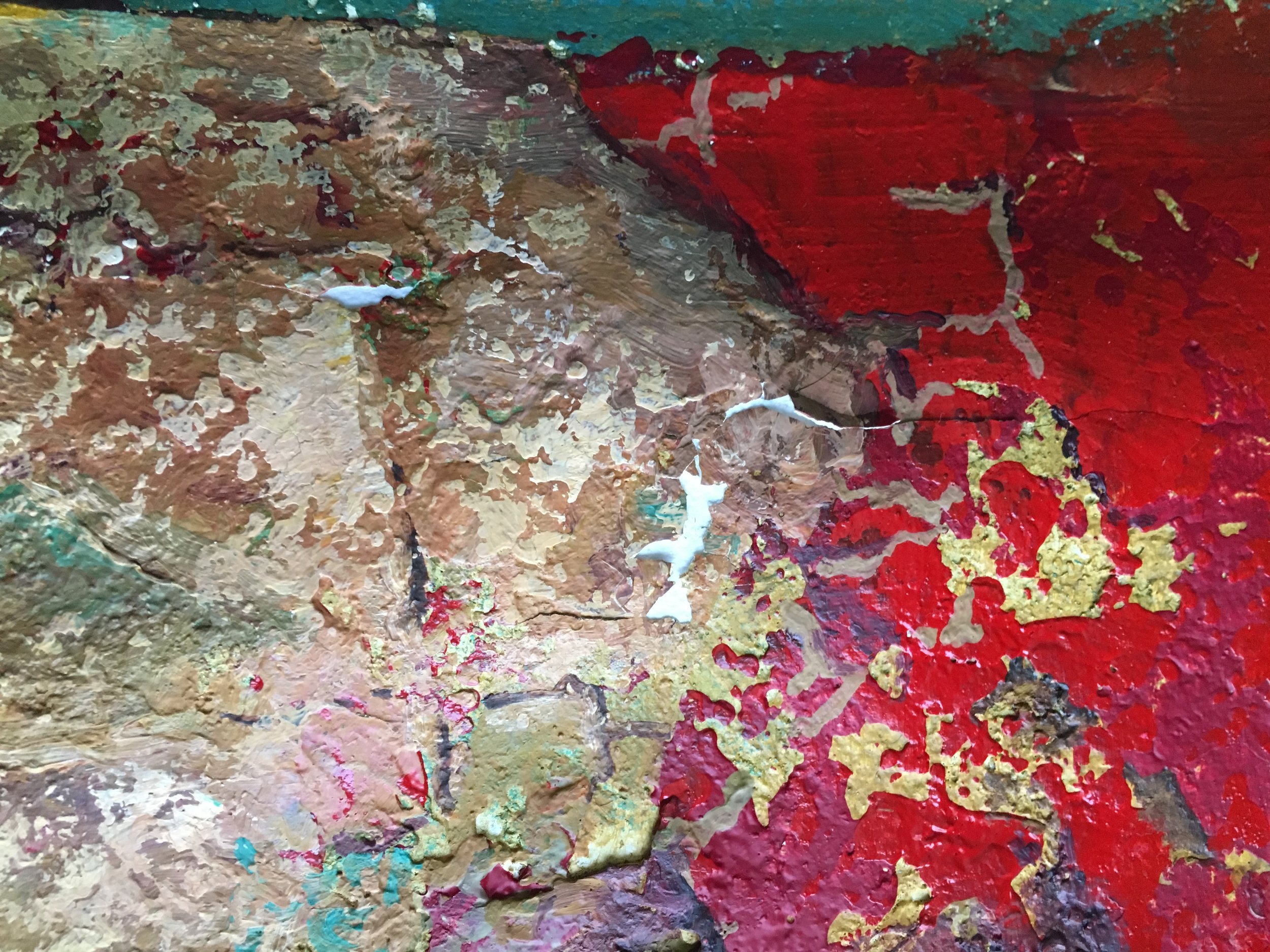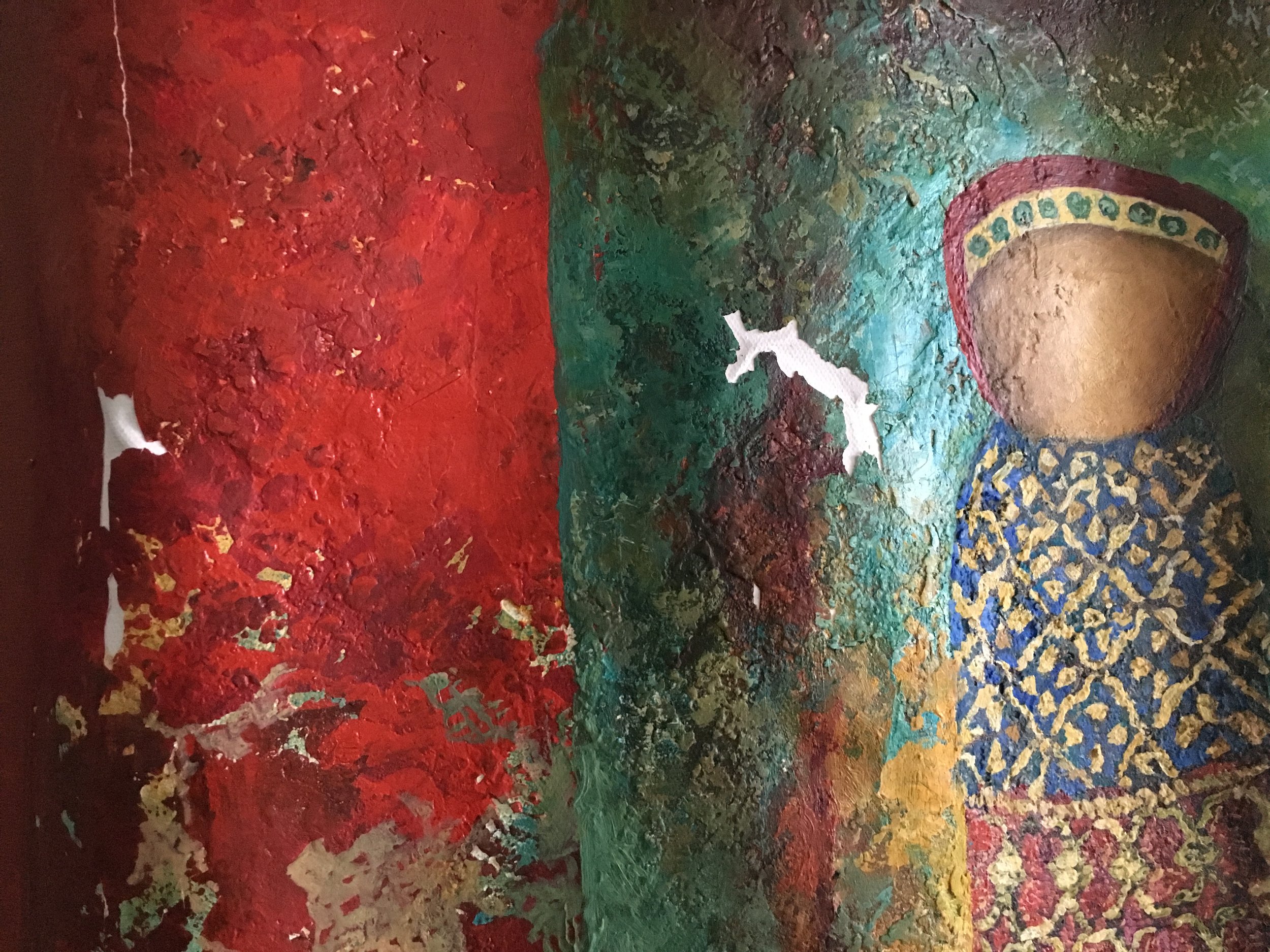Anhelos (2016)
Andrea Ringeling (b.1980)
Anhelos, 2016
oil on canvas
160 cm × 90 cm
Private collection of the author
Who, or what, are these five faceless figures? Wrapped up like babushkas in hand knitted shawls, they’re lined up like suspects in some kind of prison cave. A wonky ladder completes the symmetry but it’s too short to enable them to climb up or out, as if they could even manage. They have no appendages! Augmented with deeply hued colours and three dimensional effects, this large, mysterious work immediately caught my eyes from across the gallery/store that I randomly walked into in Valparaiso, Chile almost nine years ago.
Now here’s the catch: This isn’t the painting that I originally fell in love with.
I only spent one day in Valparaiso. It was the middle of a three week South America exploration and my girlfriend and I were enjoying a much needed city break after trekking the Inca Trail en route to Machu Picchu. Hot showers and table service meals were just what we needed, and we filled in the gaps hiking up and down the hilly coastal town photographing street art.
Needing a caffeine hit and a chance to rest our feet, we ended up in La Belle Epoque — a cafetería / textiles / orfebrería / lapislázuli / diseño / Galería de Arte. That’s where we both fell in love with the paintings by Andrea Ringeling (@a.ringeling_paintings) that were hung all over the walls. The works blended trompe-l'œil effects with weathered, abstract textures and occasionally, as with this one, strange looking wooden figures. We were drawn to the largest work in the show, Anhelos, because the colours and patterned fabrics were incredibly evocative of things we had recently experienced in Cusco. As luck would have it, a random man in the gallery was fluent in both English and Spanish and acted as translator in the acquisition of what would be the biggest souvenir I’d ever bought abroad.
That’s where this story begins.
Two months later the painting hadn’t arrived and my emails to the gallery had gone unanswered. When I paid for the work the transaction took place at a local hotel as the gallery was using their payment card readers. Since their name was on the receipt I contacted the hotel and asked for a refund but they dismissed responsibility. As I was weighing up my options the shipping gods finally delivered. I received a phone call from a courier that he had a package.
When I decided to buy the artwork I did wonder how tricky it would be to ship a 160 x 90 cm painting halfway around the world, but I was even more confused when the courier arrived. He was holding what appeared to be a rolled up tube of very creased butcher block paper. It looked like someone had sat on it and my heart sank as soon as I started to open it. It was Anhelos. The gallery had ripped it off the frame, rolled it up and very loosely wrapped it in paper. Not a sturdy cardboard tube. PAPER! Clearly they never considered the physical impacts of international shipping. Tears fell from my eyes while I carefully unrolled the artwork and watched shattered sprinkles of oil paint spill onto the floor.
The damaged original





I wrote to the gallery owner to express my disgust and she claimed they’d been shipping paintings that way for 12 years and nothing bad had ever happened, which shocked me with disbelief. But to her credit, she said they would ask the artist to paint a replacement and once that was received I should return the damaged original. I wasn’t sure how I felt about that. There was no way to know whether I’d like the new work but I didn’t feel I had any other choice.
Two months later I received a picture of the replacement and I spent a lot of time trying to spot the difference between it and the original. Andrea did a brilliant job trying to faithfully recreate the damaged painting, while ensuring a few things set this new piece apart as unique. She had been copied into many of my e-mails and was aware of what had happened. This new painting was clearly her attempt to re-light the spark that her original work gave me. The issue, however, was that this new work was in Chile and I was understandably wary about another shipment.
I was right to be.
Over the next two months there were frequent emails between me and the gallery but the painting had gone missing. The gallery owner claimed the courier “told me that the picture it's in your country, but they don't know where.” Another month came and went and I was beginning to wonder if the promise of a replacement had been a scam. It was now seven months since my original purchase and all I had ever received was excuses. I once again contacted the hotel to demand a refund and they once again dismissed me. I was beginning to assume that I was going to be left with a damaged artwork, then some additional information surfaced from a local UK depot.
Eight months after seeing Anhelos in Chile its re-painted replacement arrived safely in my flat. This work had been very carefully packaged, although no one seems to know why it spent four months taking a detour around England.
〰
When an artwork has such an emotional backstory it can take on new meaning. It’s impossible for me to look at this painting the same way that I first saw it in Valparaiso, and not just because this isn’t actually the painting that I first saw in Valparaiso. The eight months of stress that I suffered tainted my initial memory and impression of the artwork, but the new work is one that I have come to love.
It has the same visual intrigue as the original, along with a wholly new, and admittedly more optimistic, interpretation. In spite of the misunderstandings and poorly planned shipments, the gallery was generous enough to provide a replacement that the artist was sympathetic enough to paint. None of that was expected. The gallery could have refunded the money or given any number of excuses to avoid responsibility, but they didn’t. As I learned on my five day trek to Machu Picchu, the journey isn’t always going to be easy but what awaits you at the end is almost always worth it.
That’s why I like it.
The artist is so nice she painted it twice.
Additional reading:
Artist Instagram: @a.ringeling_paintings
Artist website: www.andrearingeling.cl <— Note: appears to be offline as of 01 July 2024
Previously, on Why I Like It:
Jun — King Charles III (2024), Jonathan Yeo
May — Penguin Pool (1934), Berthold Lubetkin
Apr — V&A Rotunda Chandelier (2001), Dale Chihuly






